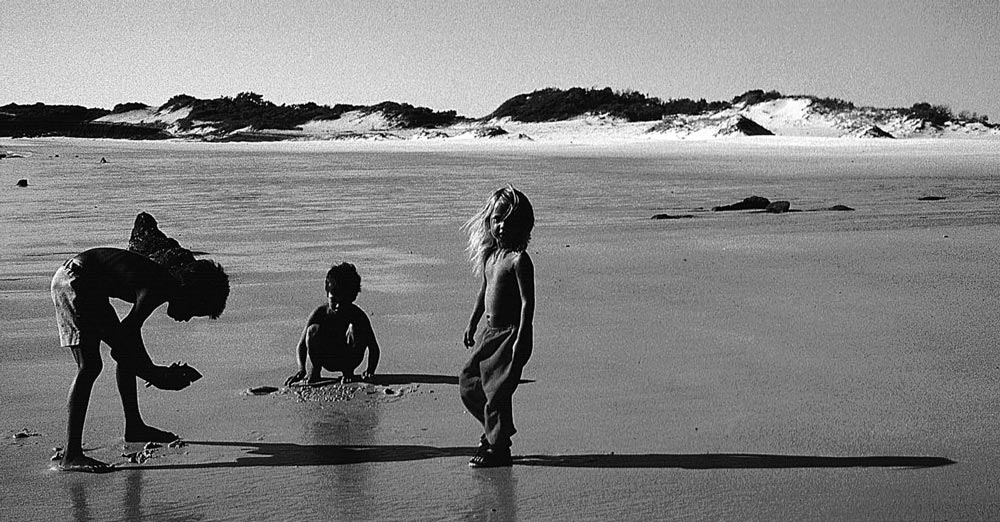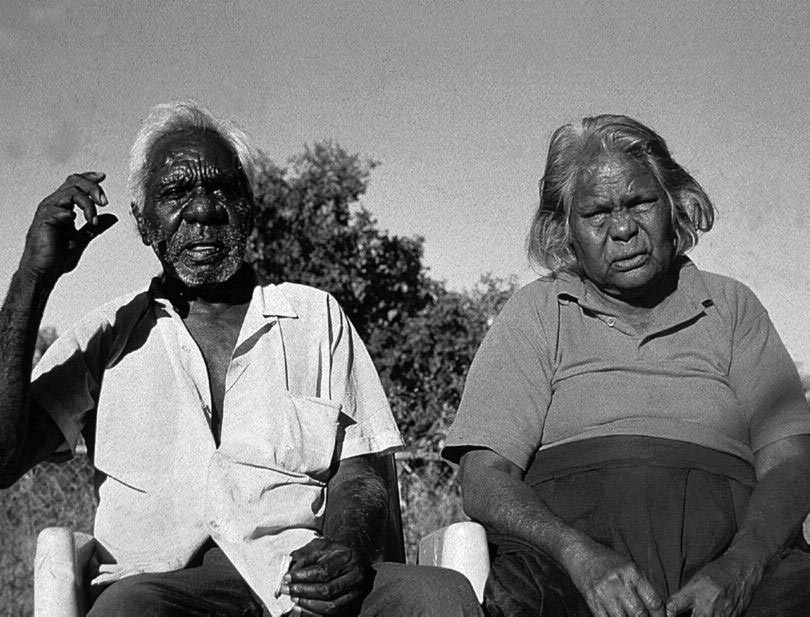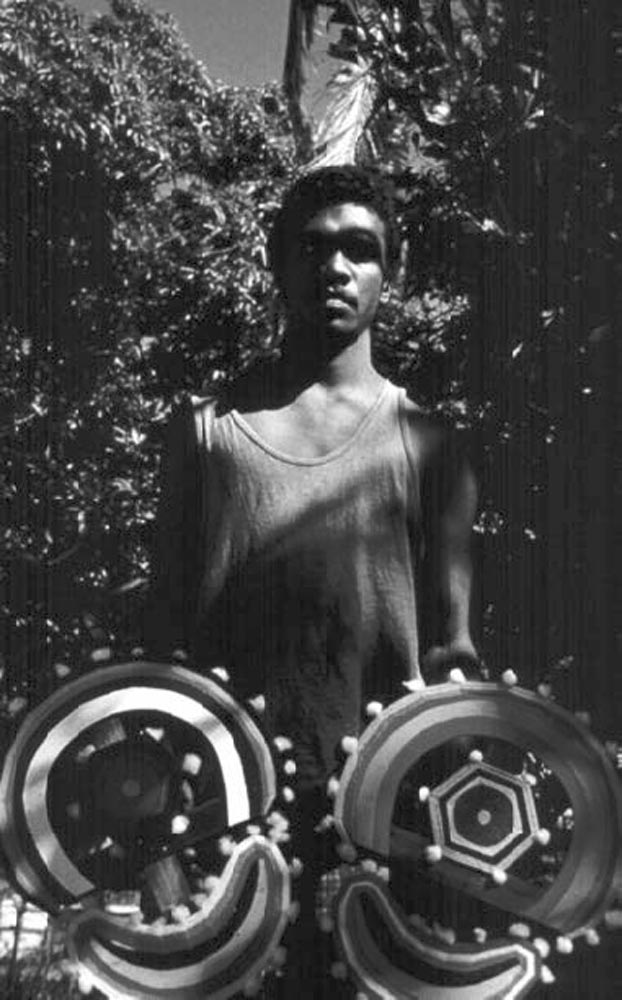
International SQUALL
Dream Land
Things could be on the up for Aboriginals down under. Do these new hopes mean the Outback is back, or will it just be another nightmare tourist trap? Sam Wild investigates.
Squall 16, Summer 1998, pp. 40-41.
The Aboriginal communities of Beagle Bay, Lombadina, One Arm Point and Sunday Island sit along a rugged track which winds up the interior of Dampier Peninsular like an inland artery. With the Great Sandy desert to the south and the Timor sea to the north it is one of Western Australia's (WA) most remote places.
Broome, the nearest big town (over 210 kilometres away), is the key supply source from which the trappings of Australian supermarket society flow three times a week in the back of a broken Nissan truck. The track is broken, pit-holed and corregated - in the wet season it becomes a river.
It is the area's size (about the same land mass of Devon and Cornwall combined) and inhospitable terrain which has proved its ultimate defence. Unlike the Dharawal people of Botany Bay in New South Wales, who were shot and bayonetted on the beach as the first British settlers landed in 1788, the Bardi and Jawi people were far away enough to escape the first wave of extermination.
A proud people with distinct languages and religious beliefs (conservative estimates identify the existence of hundreds of pre-colonial Aboriginal languages and dialects across Australia) the clans of Dampier Peninsular have managed to maintain some of their unique languages which remain as colourful expressions for the complex relationship they have with the land and sea.
While a staple diet of turtle, Dugong (sea cow) and fish are being increasingly supplemented by the convenience foods purchased at community stores they are skilled at sea harvesting and call themselves 'Saltwater People' in respect of their environment.
Despite its remoteness however, this area is not without its ghosts. The legacy of murderous pearl-lugging crews, culturally repressive Christian missionaries and the institutional violence associated with draconian governmental legislation (including the forced removal and fostering of Aboriginal children by white families) has left its mark on the people and their culture.
Ironically, it was the Catholic missionaries, who suppressed the native languages and enforced the self-consious values of the Papal order, who finally convinced the WA Government to grant the land of Dampier Peninsular as a reserve in the mid 1950s which established some form of patronising legitimacy for the local communities.
Dampier Peninsular, like much of Australia, is now awash with land rights cases and local people are increasingly becoming embroiled in lengthy legal battles to re-establish their historical and legitimate rights to ownership of their land. They are not alone.
For the first time in Australian political history the bipartisan acceptance (by the Australian Liberal and Labour parties) of restrictive Aboriginal land rights legislation has been challenged with visible political effects. Full land rights, and the ownership, control and use of their associated resources by indigenous communities, are now taking priority in Australian politics.
The Labour Party deputy opposition leader Gareth Evans in the Australian Houses of Parliament recently illustrated his feelings on a ruling by the High Court that a disputed bridge between Hindmarsh island and the South Australian mainland had been given the go-ahead despite objections from local Ngarrindjeri clan. Berating Liberal Party Prime Minister John Howard, who had given his tacit support to the bridge-building lobby, he declared that he "seems to be never so happy as when he's bashing blackfellas".
The episode has cut to the nerve of Australian politics and threatens to divide the current conservative coalition Government run by John Howard, who may have to hold elections if he cannot get warring factions to agree on the most radical reassessment of Australian land rights in history. For the first time press photographers have been barred from entering the debating chamber on the grounds that the issues are too sensitive. Australian democracy is experiencing change on a scale which would have been inconceivable even ten years ago.
These seminal changes in values concerning land ownership ride on the backs of two crucial decisions made by the Australian High Court - Mabo in 1992 and Wik in 1996.

The Mabo decision, which underpins the 1993 Native Title Act, officially dismantled 200 years of 'Terra Nullius' (land unoccupied) which had been established by Captain Cook in 1770 and provided the rationalisation for the settlement of Austrlalia and the destruction of its indigenous population.
Both the Mabo and Wik decisions are named after the Aboriginal tribes who challenged the ownership of land to which they had ancestor-linkage, including the Wik people whom the High Court ruled had their land forcibly removed from them in the 1950s in order to accommodate a mining lease. This now famous two-year old ruling has opened up areas of land, where mining/pastoral operators and Aboriginal people co-exist, to debate and accounts for approximately 40 per cent of Australia's arid interior.
A crucial issue, in addition to the deep-rooted cultural and spiritual relationship indigenous Australians have with the land, is that of the control of resources. Lucrative deals involving mining contracts, construction projects and tourism will now necessitate the equal involvement of Aboriginal communities where they are the land-owners.
Dampier is no exception with families, clans and communities attempting to establish their basis of ownership upon areas of territory. Here it is tourism that is being mooted as the cure-all for many of the region's economic problems which includes an unemployment rate amongst Aboriginals three times that of Australia's average.
The unique ecosystems and outstanding natural beauty of the Kimberley region (itself the size of Poland), with Dampier Peninsular sitting to the left, make it an ideal place for tourist development.
The push for financial self-sufficiency, and a movement away from dependency on ever-decreasing governmental assistance, remains a target for the few small-scale, community-based tourist enterprises which exist along the coast.
Goolamionon community is situated two kilometres off the main track, where a fire constantly burns in the central clearance with several huts and four-wheel drive trucks in various states of repair dotted around the place.
Sat in the shade, with a young film-making couple videoing the interview for a documentary, Patrick Sampi (an Aboriginal elder and land-owner) explains the thinking behind his tourism venture located on the nearby ten-kilometre long beach. "Maybe in times to come we'll get nothing (from the government) - so we've got to start acting now and take control. We're not going to charge a lot, we're starting small - $20 a night or whatever. If I give them small fees they'll expect something small back."
It is not an ambitious plan and Patrick is learning from the experiences of the key Aboriginal-owned Kooljaman resort at Cape Leveque. A popular resort with adventure tourists the facility serves as an example of how a successful tourism venture can work, winning the prestigious Sir David Brand tourism award in 1997.
Its popularity owes something to the rising number of tourists in WA, an increase of 48 per cent between 1984/85 and 1994/95, and its unique location which enjoys spectacular peninsular-top views. Tourists who fly, drive or sail to the beautiful location do so to enjoy unrivalled fishing within pristine natural surroundings.
However, tourism comes at a cost and warning signs are visible. As Trudi Ridge, an Aboriginal tourism advisor explains. "To a degree these communities are opening up their lives to tourism - it's a huge lifestyle change for people. Aboriginal tourism needs to provide an experience of Aboriginal culture without compromising indigenous culture."
It is a tall order and, despite the initiatives aimed at establishing increasingly popular cultural tourist activities, there is a divide between the tourist haven of Kooljaman resort and the local community of One Arm Point. Most exchanges are limited to a mid-journey petrol fill-up and drinks purchase.
Ice-boxes, flash new four-wheel drive vehicles and top of the range adventure equipment, with flip-flops and fishing conversations filling the long evenings around the municipal barbecues, set the atmosphere at the resort.
Neil, who has travelled 2,000 kilometres from Darwin with three friends explains. "We've been saturated with Aboriginal culture in the Northern Territory, we're not interested."
While this level of intolerance may be limited there is still a reluctance to engage with the deeper and more profound nature of Dampier's Aboriginal history. "We've gone and had a look... but we haven't had much interaction with the locals. We're here for the fishing, nothing else really," chips in Neil's mate Tony.
Down by the reception area an ancient Co'oboree is being re-enacted for a crowd of on-lookers. Ironically, these occasional events are credited with providing the opportunity for young people to re-learn ancient customs given the financial value given to them by tourist dollars.
Jeremy Wigan, 18, is a dancer with the Bardi Ardyooloon Dance Group. He enjoys the fact that he has spent time absorbing the culture and history of his parents and older generations but he remains concerned for his peers. "I'm the youngest of six and I'm the only one who's interested - young people go through (initiation) but there are other stages and they don't know them. In twenty years we won't be looking at our culture - we'll just have stories."
While he is saddened by the attitudes of his own generation he feels that white and black culture can co-exist. "I can dance Co'oboree but when I go to a nightclub I can dance white too, I'm both ways."
Nevertheless, Jeremy is exceptional and many elder Aboriginals feel that their culture is on a downward spiral. Kharki Stumpagee, a full-blooded Jawi from Sunday Island, is the last remaining speaker of his native tongue, Jawi. It is moving to hear him sing the dugong song his parents taught him as a boy in which they thank the dugong, nature and the hunters for their food. It is reflective of a culture which held the ecological balance in high esteem. "Not a big mob speak Jawi any more. When I was a boy we all spoke Jawi. Jawi is gone then nothing left. I'm already sad. I got no other old people to talk with in Jawi."
Getting to Sunday Island is a risk worth taking.
The 10-metre tide is the second greatest in the world and the billions of tonnes of water which roll in and out every six hours create whirlpools powerful enough to suck down boats (or so the legend goes). Saltwater crocodiles, Tiger sharks, Blue-ringed octopus and King Brown snakes populate the island and the surrounding sea. Yet it is here that an ambitious plan is being hatched by Kharki and a handful of his relatives and friends including Norm Archer.

Norm, 60, (a Bethnal Green cockney who emigrated to Australia in the 1960s) has lived with the Aboriginal communities of the Kimberely for twenty years and has helped build typhoon-proof houses on the island where he lives with his extended Aboriginal family. Together with his compatriots he shares a dream of establishing a functioning tourism business which would provide the basis for sustainable existence.
"The whole idea is to create an individual self-supporting community where our kids can go to school, make ourselves people again instead of being numbers on a dole cheque. We can say we made this, like the old people who were proud of what they did."
Numbers of visitors are increasing and several groups of tourists from as far afield as Denmark, the US and Japan have stayed in the cramped but hospitable tin huts allocated for guests.
However, there are several factors holding development of the island back -namely Native Title. Kharki, Norm and the Sunday Island community are collectively fighting the first sea rights claim for use of the marine resources which is being challenged by the WA Government on behalf of the fishing industry.
Geoffrey Bagshaw, a consultant anthropolgist for the Kimberley Land Council, (an organisation involved in the lengthy legal wrangles taking place between the warring factions of government, industry and indigenous populations) explains the logic behind the Land Rights issue and defends the costly legal battles cuurently being waged across Australia. "This country needs to come to terms, not only with its past, but with reality today. Land rights have to be resolved, and that costs money."
In addition, the environmental implications of development are being considered alongside the need to maintain privacy of the Law Grounds (vast areas of sacred land where secretive Aboriginal ceremonies take place and which are closed to women, children and non-Aboriginals). As Norm reiterates: "Tourism has got to be controlled properly - you can't have too many people clambering over the reef. You make your rules and make sure people stick to them. For instance people have to go on guided tours - Sunday Island is full of Law Grounds."
Ian, a tall ex-boxing champion and a relative of Kharki's, suddenly recounts the experience of a man who stayed on the island while working on the construction of several of the huts. "This one bloke - he come here and was going everywhere by himself, I tell him not to but he didn't listen. One day he come back and said he saw a ghost. He was 'Garangee' after that - you know, he went mad."
Like the cultural enviroment, the island's fragile ecosystems can easily be disturbed and several groups, including Sunday Island's residents, are observing changes in marine life.
Doctor Tasman Crowe, Research Assistant at the Northern Territory University, is observing the populations of Trochus (which local people gather from around the reefs and then sell as button material; there is an unceasing demand for the hard-wearing and attractive shell from the designer fashion world). Dr Crowe is responsible for the Trochus re-seeding project which aims to replace the population depleted in part through over harvesting. "It's a direct source of money that can be obtained in a relatively traditional way."
This is combined with an increasing awareness that local people need the skills and tools to polish the shells once they have been collected. "The cost per unprocessed shell per kilo is a fraction of that paid for polished shells - it's called 'value adding'," explains Dr Crowe.
Taking control of the resources, and the associated wealth, attached to the land represents a significant mood swing for Australia and all its people. There is at last a chance that genuine autonomy and power-sharing built around economic independence is a possibility for indigenous communities. The land from which all life eminates is an attainable possibility.
Thirty three kilometres outside Broome the road to One Arm Point runs out of tarmac and descends into a ridged bone-shaking sunbaked sand pit. There are rumours that a casino construction company has eyed an area of land along the track, promising it would carry out the $180 million task of laying a paved road in return for a prize piece of untouched territory.
A stable road will change the nature of the peninsular forever unleashing new levels of traffic on the pristine outback environment. It is a choice between economics and ecology, underwritten by Land Rights and resource control, which local communities will have to make. The road that local people choose to follow will have lasting implications. The dilemma confronting many Aboriginal communities today is an invasion of a different kind.
